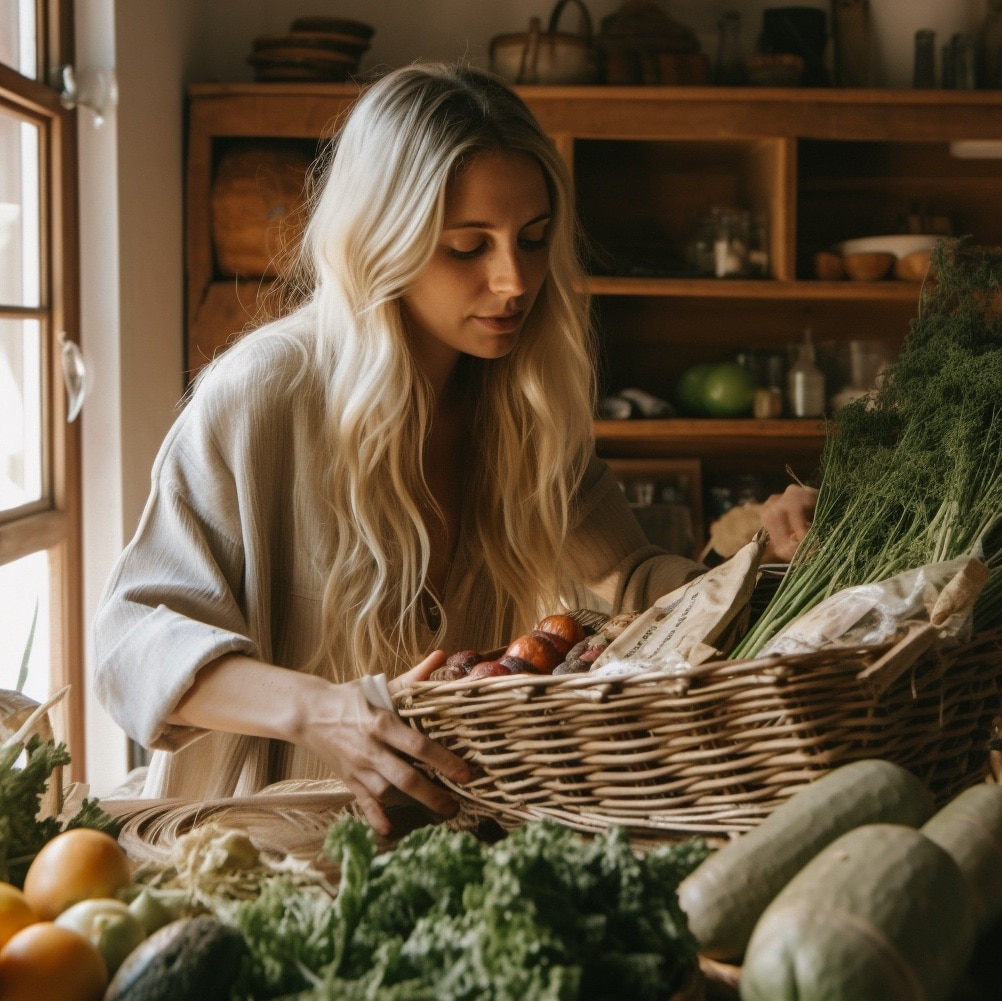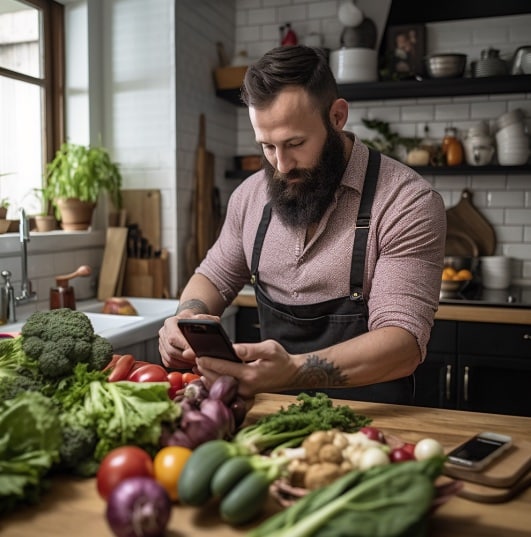Introduction – Edible Food Scraps
Food waste is a global issue that negatively impacts our environment, contributing to the overall carbon burden and burden on natural resources. One way to counter this issue is by adopting eco-friendly and sustainable living practices, which include finding innovative ways to utilize edible food scraps beyond composting. This article presents various creative methods to make the most of your food scraps, embrace a greener lifestyle, and contribute to a healthier planet

Cooking with Edible Food Scraps
Incorporating food scraps into your cooking regimen is a practical step that simultaneously reduces your carbon footprint and helps you economize. By repurposing these often overlooked ingredients, you not only eliminate waste but also unlock a trove of potential flavors for your meals.
To maximize the usability of these scraps, it’s critical to properly store and preserve them. Investing in sustainable storage options such as re-usable silicone bags – Stasher bags being a popular choice – is a smart move.
Other eco-friendly alternatives such as glass containers and beeswax wraps are effective in maintaining the freshness of your food scraps while aligning with a greener lifestyle. By embracing these practices, you’ll elevate your culinary adventures while contributing positively to the environment.
For culinary inspiration, consider the following methods:
Vegetable Scraps Stir-fry: Collect clean vegetable scraps like peels, stems, and leaves, and transform them into a delicious and nutritious stir-fry dish.
Homemade Broth: Simmer bones, vegetable scraps, and herbs in a slow cooker or Instant Pot to create a flavorful base for soups, sauces, and other recipes.
Zero-waste Pesto: Discarded carrot tops, beet greens, or other leafy vegetable stems can be turned into a delicious pesto to enjoy with pasta, sandwiches, and salads.
Re-growing Herbs and Vegetables: Many herbs and vegetables can be re-grown from cuttings or scraps, providing you with a continuous supply of fresh produce.
Aquafaba – Ultimate Food Scrap
If you’ve ever opened a can of chickpeas and poured out the liquid, then you would have wasted the foundations of a culinary sensation thats spread across the internet: aquafaba. The liquid in canned chickpeas was found by one person to be a suitable substitute for egg whites, which can be beat and turned into a fluffy mixture for aquafaba desserts. Take inspiration from this – anything you’re throwing away it has the potential to be a real sensation and great utility like aquafaba!
Repurposing Edible Food Scraps for Eco-Friendly Household and Gardening Tasks
Transforming food scraps into valuable assets for household and gardening chores is an ingenious way to champion sustainability. These often disregarded kitchen byproducts can take on a new life as natural cleaning agents or resources for your garden, presenting a compelling alternative to synthetic products.
This practice not only significantly minimizes waste but also lessens your home’s dependency on artificial and potentially harmful substances. The transition to using food scraps in this way isn’t merely eco-friendly—it’s a holistic approach that integrates environmental mindfulness into the fabric of your daily chores and gardening practices, further reinforcing a sustainable lifestyle.
In household cleaning, try the following:
Citrus Rinds for Scented Vinegar: Submerge citrus peels in a jar of white vinegar and let them infuse for a few weeks. The result is a powerful, eco-friendly cleaner with a pleasant citrus scent.
Coffee Grounds as a Scrubbing Agent: Used coffee grounds make an excellent abrasive scrub for cleaning pots, pans, and surfaces without using harsh chemicals.
Banana Peels for Shining Silverware: Gently rubbing the inside of a banana peel on tarnished silver can help restore its shine.
In the gardening arena, food scraps can serve several functions:
Eggshell Fertilizer: Don’t want to throw away old eggs? Crushed eggshells act as a great fertilizer, providing your plants with much-needed calcium.
Citrus Rind Seed Starters: Fill hollowed-out citrus rinds with soil and plant seeds for an eco-friendly and biodegradable seed starter.
Green Waste Mulching: Use leaves, grass clippings, and other green waste as a nutrient-rich mulch in your garden.
Feeding Food Scraps to Animals and Insects
While not common in every household, those who raise chickens can find a worthwhile application for food scraps: they can serve as an economical and sustainable feed source. Providing chickens with these leftover bits not only recycles waste but also aids in generating a renewable protein source through the eggs they produce.
As this practice requires a certain level of knowledge and care, it’s essential to research the types of food appropriate for chickens to avoid any potential risks.
This concept of repurposing food scraps extends to other areas of sustainable living as well, such as vermicomposting. In this eco-friendly process, worms consume organic waste (including certain types of food scraps), turning it into nutrient-rich compost.
As with feeding scraps to chickens, it’s important to research which scraps are suitable for this type of composting. Hence, whether you’re feeding chickens or composting worms, food scraps can play a crucial role in supporting a more sustainable lifestyle.
Sustainable Ways to Reduce Food Waste
Adopting a sustainable lifestyle often begins with small, deliberate steps, and one such critical step is the reduction of food waste. There is a wealth of strategies that can help mitigate this issue, making it accessible and feasible for anyone willing to make the commitment.
These strategies range from innovative cooking techniques to mindful shopping habits, each playing a significant role in fostering a more sustainable lifestyle. In the following sections, we will delve into some of these key strategies that can help curtail food waste effectively and sustainably.
Meal Planning and Smart Grocery Shopping: Use digital apps like Olio and Too Good To Go for food-sharing or shopping local and supporting organic or bio-dynamic food producers.

Olio is a unique food-sharing app that aims to reduce food waste at the community level. It enables individuals to post and share surplus food items that might otherwise go to waste. This could be anything from home-grown vegetables, store-bought items that won’t be used in time, or leftovers from a meal. The app facilitates the redistribution of food within local communities, reducing waste and helping to feed those who could benefit from these shared resources.
Too Good To Go focuses on saving surplus food from stores and restaurants that would otherwise be discarded. The app allows you to purchase ‘Magic Bags’ from participating businesses. The content of these bags is a surprise and typically consists of items that weren’t sold by the end of the day. This provides an opportunity for users to enjoy discounted food, while simultaneously helping businesses reduce their waste.
Proper Food Storage Techniques: Learn about the best ways to store fruits, vegetables, and other perishables to extend their shelf life and keep them fresh.
For instance, certain fruits and vegetables, such as bananas and tomatoes, emit a gas called ethylene as they ripen. This gas can speed up the ripening process of other fruits and vegetables, causing them to spoil more quickly. Therefore, it’s beneficial to store ethylene-emitting foods separately from others.
Additionally, some fruits and vegetables prefer cooler, humid environments, such as the refrigerator, while others thrive in warmer, dry environments, like a pantry or countertop. For example, leafy greens and berries generally last longer when refrigerated, whereas potatoes and onions should be stored in a cool, dark, and well-ventilated place out of the fridge.
Upcycling Leftovers into New Meals: Transform leftovers into entirely new dishes to minimize waste and create diverse meal options.
The concept of upcycling leftovers revolves around creatively repurposing your remaining food from previous meals into entirely new dishes. This practice not only helps minimize food waste but also encourages culinary creativity and diversifies your meal options.
Upcycling could be as simple as incorporating last night’s roasted vegetables into a hearty omelet for breakfast or transforming leftover grilled chicken into a refreshing chicken salad for lunch. Another common practice is to blend remaining vegetables and broth into a comforting soup or use leftover rice to prepare a quick and delicious fried rice dish.
Education about Waste Reduction: Spread the word about food waste and share tips on reducing it within your community and social circle.
Education plays a pivotal role in combating food waste, as awareness often precedes action. Spreading the word about the detrimental impact of food waste, both on our environment and economy, is crucial to inspiring change within your community and social circles.
This advocacy can take various forms. One could host informative sessions, write blog posts, or create social media content focusing on the issue of food waste and its reduction. These platforms could be used to share practical tips on how to reduce food waste, such as meal planning, proper food storage techniques, upcycling leftovers, and composting.
Eco-Friendly Food Scrap Initiatives and Organizations
There are various initiatives and organizations dedicated to reducing food waste:
Food Scrap Donation Programs: Use services like GiveBackBox or neighborhood “fridges” and “pantries” to donate excess food or food scraps, redirecting them to those in need.
Food Waste Management Programs: Some municipalities offer city-sponsored curbside food waste pick-up or have community composting facilities.
Bio-digesters and Renewable Energy: Innovations like HomeBiogas create renewable energy from food waste, which is perfect for households looking to go off-grid.
Conclusion – Edible Food Scraps
Adopting eco-friendly and sustainable living practices is both rewarding and essential for a healthier planet. By implementing the ideas shared in this article and sharing your own experiences and tips with others, you can make a difference in reducing food waste and embrace a greener lifestyle for generations to come.
